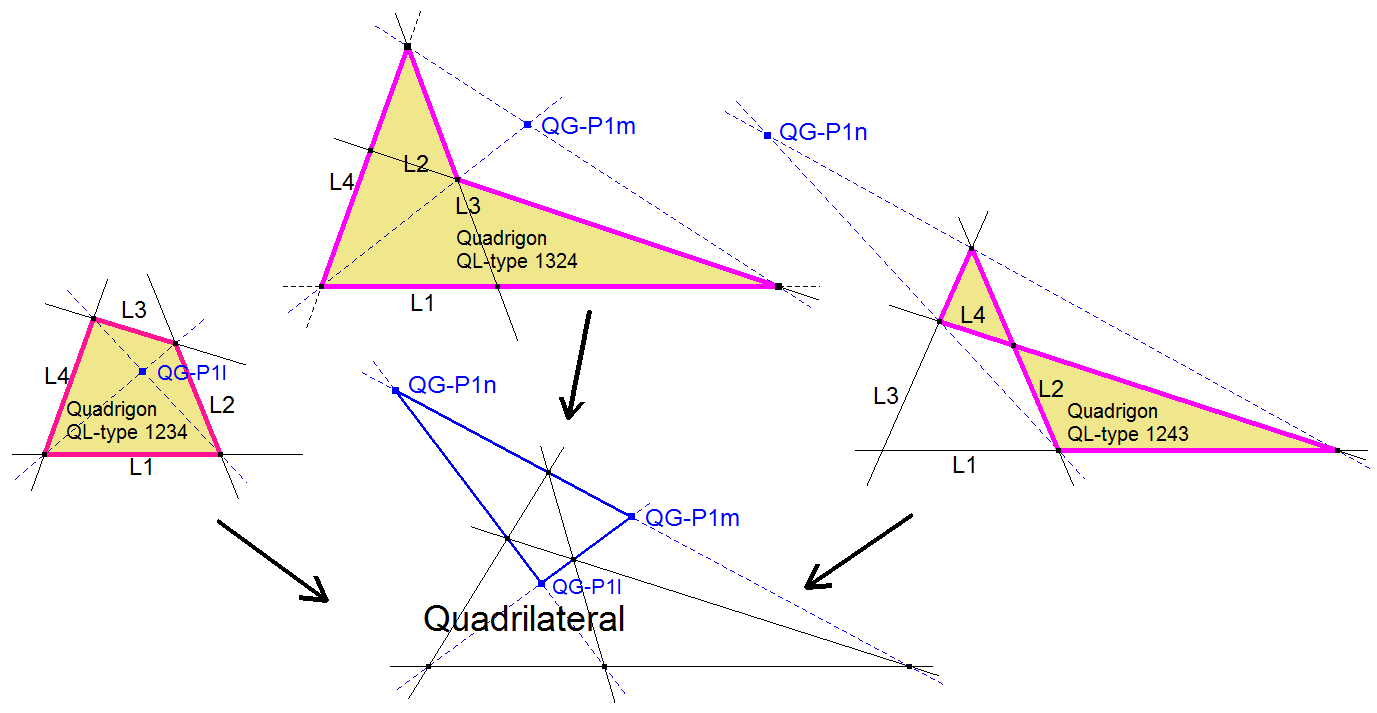QG-P1: Diagonal Crosspoint
In a Quadrigon the vertices P1, P2, P3, P4 have a fixed order.
The Diagonal Crosspoint is the intersection point of the 2 lines connecting opposite points.
Four points can be ordened in 6 ways:
P1-P2-P3-P4
P1-P2-P4-P3
P1-P3-P2-P4
P1-P3-P4-P2 = reversed sequence of P1-P2-P4-P3
P1-P4-P2-P3 = reversed sequence of P1-P3-P2-P4
P1-P4-P3-P2 = reversed sequence of P1-P2-P3-P4
When we take into account that some sequences are reversed sequences, only 3 types of Quadrigon-orders remain: P1-P2-P3-P4, P1-P2-P4-P3 and P1-P3-P2-P4.
This means that a system of 4 points - also named (complete) quadrangle - consists of 3 quadrigons: P1-P2-P3-P4, P1-P2-P4-P3 and P1-P3-P2-P4.
These 3 quadrigons in a quadrangle produce different Diagonal Crosspoints as can be seen in next picture.

In the same way a system of 4 lines - also named (complete) quadrilateral - consists of 3 quadrigons: L1-L2-L3-L4, L1-L2-L4-L3 and L1-L3-L2-L4.
These 3 quadrigons in a quadrilateral produce different Diagonal Crosspoints as can be seen in next picture.

Coordinates:
CT-Coordinates in 3 QA-Quadrigons:
- (p : q : 0), (0 : q : r) and (p : 0 : r)
CT-Coordinates in 3 QL-Quadrigons:
- (–m n : l n : l m), (m n : –l n : l m) and (m n : l n : –l m)
CT-Area of QG-P1–Triangle in the QA-environment:
- 2 p q r Δ / ((p + q) (p + r) (q + r)) = area QA-Diagonal Triangle
CT-Area of QG-P1–Triangle in the QL-environment:
- 4 l2 m2 n2 Δ / ((-l m + l n + m n) (l m + l n - m n) (l m - l n + m n)) = area QL-Diagonal Triangle
DT-Coordinates in 3 QA-Quadrigons:
- (0 : 0 : 1), (0 : 1 : 0) and (0 : 0 : 1)
DT-Coordinates in 3 QL-Quadrigons:
- (0 : 0 : 1), (0 : 1 : 0) and (0 : 0 : 1)
DT-Area of QG-P1–Triangle in the QA-environment:
- S / 2
DT-Area of QG-P1–Triangle in the QL-environment:
- S / 2
Properties:
- The 3 Diagonal Crosspoints in a Quadrangle form the QA-Diagonal Triangle (see paragraph QA-Tr1: QA-Diagonal Triangle).
- The 3 Diagonal Crosspoints in a Quadrilateral form the QL-Diagonal Triangle (see paragraph QL-Tr1: QL-Diagonal Triangle).
- QG-P1 lies on these lines:
- QG-P1 is the point with minimal sum of distances to the vertices.
- QG-P1 is the Railway Watcher (see QL-L-1) of QG-L4 and QG-L5, the 1st and 2nd QG-Quasi Euler Lines (note Eckart Schmidt).
- QG-P1 is the Diagonal Crosspoint of the 2nd Quasi Incenter Quadrigon (explanation "2nd Quasi", see QG-P8).
-
QG-P1 is the Isogonal Conjugate of QG-P16 (Schmidt Point) wrt the Miquel Triangle (QA-Tr2). (Eckart Schmidt, November 26, 2012)
- The QA-Orthopole (QA-Tf3) of QG-P1 is a point on the Newton Line QL-L1.
- The QA-Möbius Conjugate (QA-Tf4) of QG-P1 is a point on the line QA-P4.QG-P18.
- The QL-Clawson-Schmidt Conjugate (QL-Tf1) of QG-P1 is QA-P4.
- When the Reference Quadrigon P1.P2.P3.P4 is convex, then Area(QG-P1.P1.P2) * Area(QG-P1.P3.P4) = Area(QG-P1.P2.P3) * Area(QG-P1.P4.P1). See Ref-41, pages 27,28.
- The circle defined by the 3 versions of QG-P1 (QA-Ci1) in a Quadrangle is incident with QA-P2 and QA-P30.
- The Triple Triangle of QG-P1 is perspective with all QA-Component Triangles (see QA-Tr-1 for Desmic Triple Triangles).